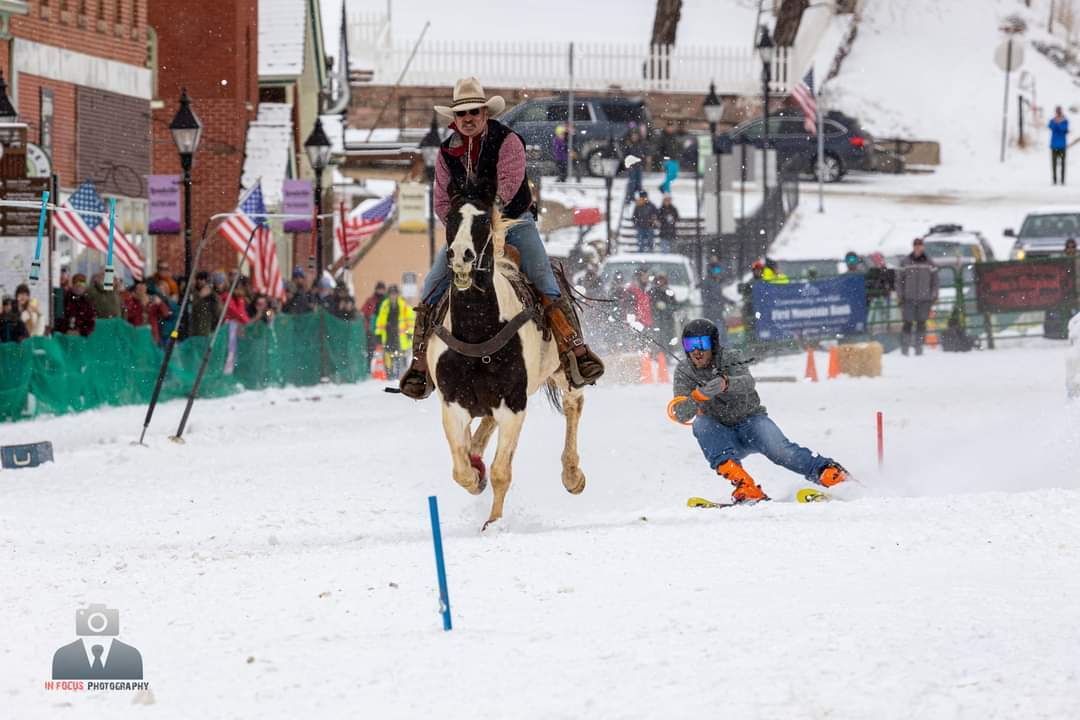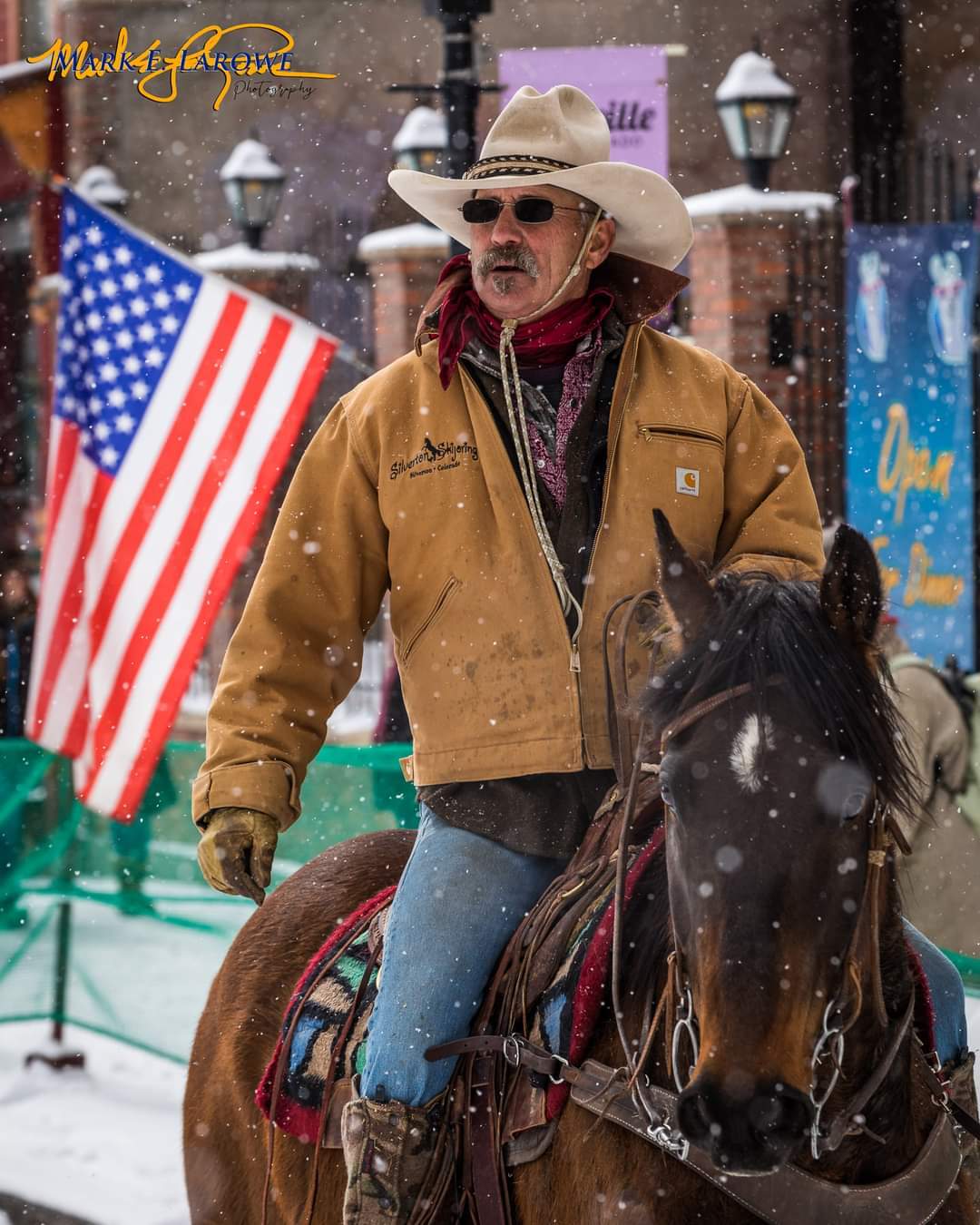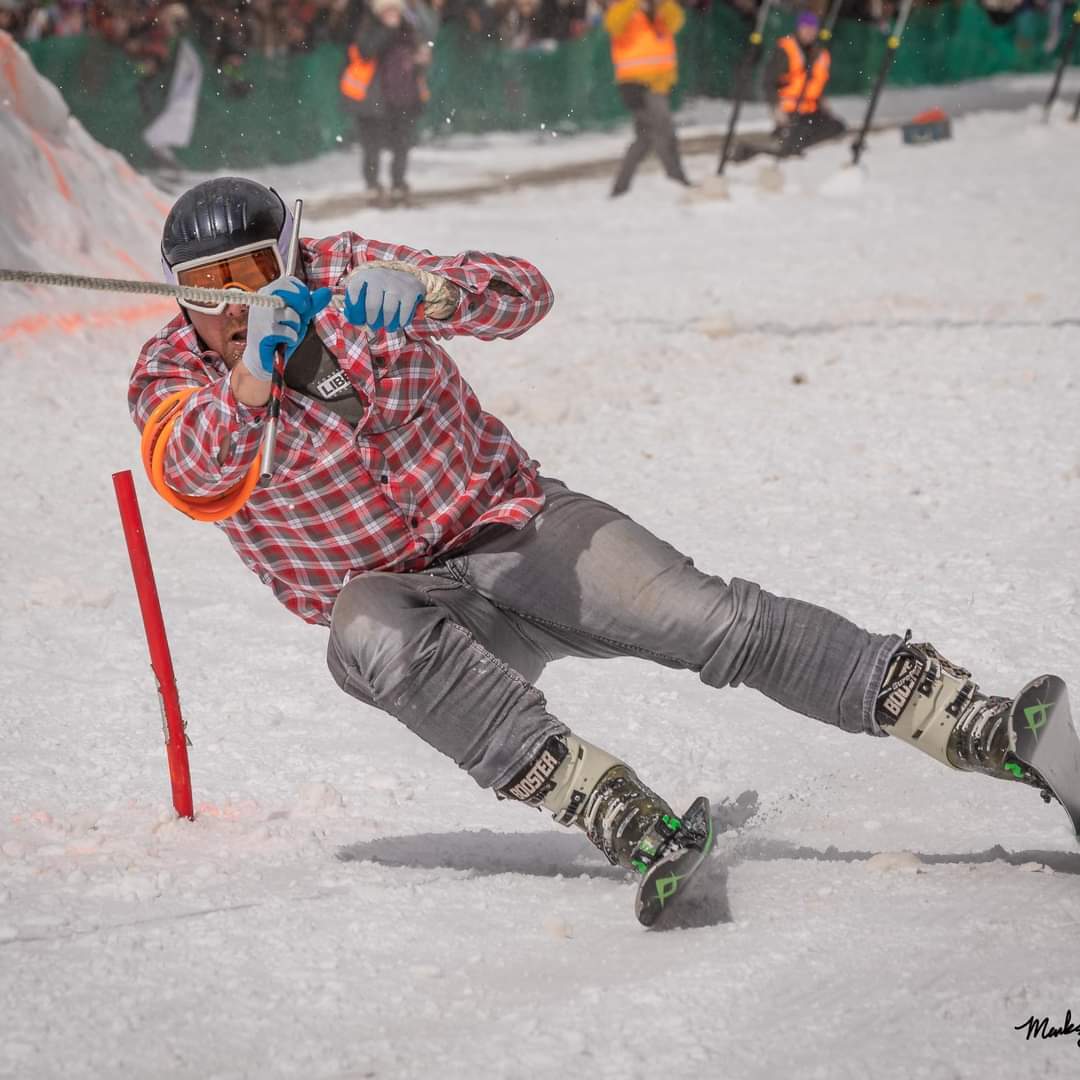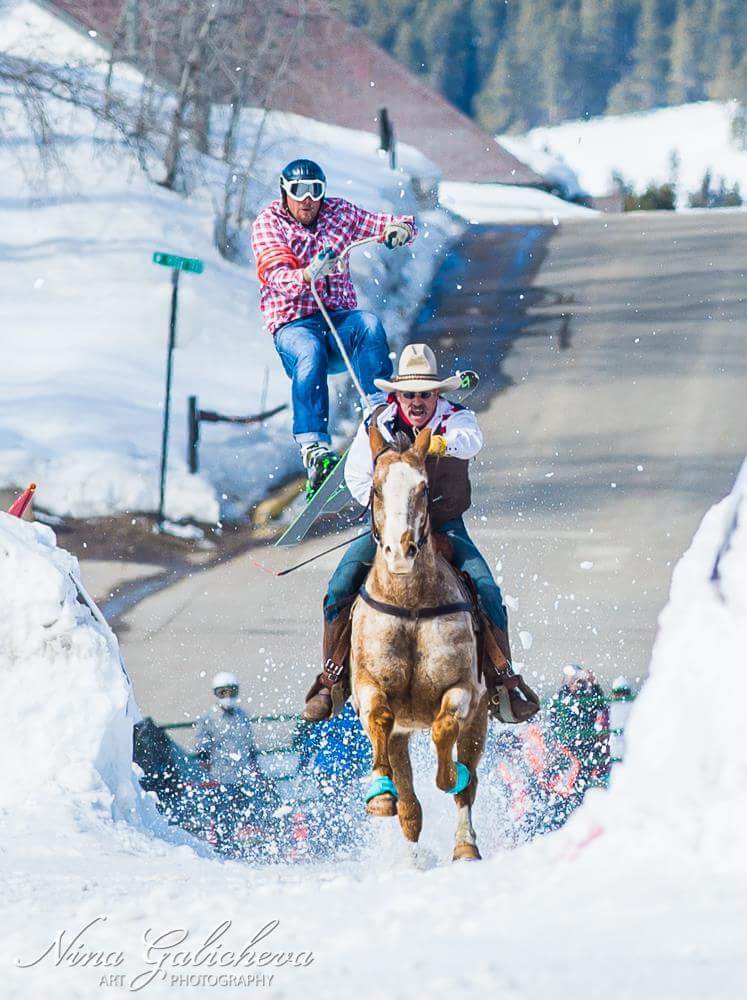In the small Colorado mountain town of Leadville, thousands of spectators flock to the sidewalks of Main Street on the first weekend of March to watch skiers and cowboys race. Not in separate events, as one might expect—the horsemen and the snow athletes compete together.
The annual Leadville race has a long history, occurring each year since 1949. The event starts with a blanket of snow over a roughly 800-foot section of the road, topped with various ramps, rings, gates and other ski obstacles. American flags lining the street snap in the brisk Colorado wind as fans crowd the sidewalks, jostling for a spot close to the barriers to feel the spray of snow when a horse thunders past. Main Street, flanked on either side with quaint small-town storefronts, comes to life.

Skiers face an array of obstacles on the track, ranging from ramps, flags, gates or poles. Courtesy of Jeff Dahl
Meanwhile, at the starting point, a horse is snuffing and prancing with anticipation. He knows what’s coming; his only mission is speed, and his cargo? A skier, pulled behind by a 30-foot rope.
This is the sport of skijoring: unusual to some, an adrenaline rush to others and outright madness to many, it’s derived from a Norwegian word translated to “ski driving,” from a time when Norwegians used large saddled beasts to hitch a ride on skis.
Now, skijoring is more for the adrenaline seekers and less of a snowy taxi service. Three such seekers shared their stories to help more people understand this unusual but thrilling hobby.
Meet the Skijoring Stallions
As all cowboys know, horses love to run.
“Each horse has its own personality,” Jeff Dahl, a skijoring rider since 1995, explained to Kinute. “Some can be more fired up. I sometimes say that we’re just riding fire-breathing dragons.”

Jeff Dahl at a skijoring competition in Leadville. Dahl, a lifelong cowboy himself, has been in the skijoring world since 1995. Courtesy of Jeff Dahl
Many skijoring horses may have a background as a racehorse or rope horse. Horses, Dahl said, get an endorphin rush from being able to run full speed. Galloping down the straight-shot Leadville skijoring track, the horses (and, consequently, the human tethered to the horse on skis) reach top speeds of 50 mph.
“That’s what makes [the sport] unique, it’s the horse,” Dahl said. “Going behind snowmobiles is not the same thing. It also doesn’t create the same excitement. People come to see horses run and see the skiers go off the high jumps.”
The animal’s energy when it knows a race is coming is palpable; the horses will stomp in excitement, nostrils flaring with foggy breaths in the cold mountain air. Skijoring competitions are often won by just a few tenths or even hundredths of a second, so the speed of a horse plays a critical role in a winning run.
A skijoring run only lasts 15-20 seconds, but a horse running at top speed can’t and shouldn’t come to an immediate halt. After crossing the finish, the skier lets go of the rope and the horse runs another length equidistant to the track to slowly cool down.
As another skijoring veteran and Leadville native Jerry Kissel explained, this is because horse safety is a top priority for skijorers. The sport even has an advisory committee that inspects the tracks and makes recommendations for maximized safety. The snow blanket must be carefully monitored to ensure it doesn’t pose potential harm to a horse by causing it to lose its footing.
“A perception of us not caring about our animals, that would be the worst thing we could have,” Kissel told Kinute. “... If a horse goes down, the crowd goes quiet. You can hear the murmurs, everybody’s worried.

Jason Dahl, pulled behind a horse by father Jeff Dahl, is ready for liftoff. In skijoring, skiers fly off 7- to 8-foot jumps at top speeds of 50 mph. Courtesy of Jeff Dahl
“You can hear and feel the movement of them animals down the avenue. They’re energized, they’re pumped. It’s built in. They want to keep running. If you get them started, they don’t really want to shut down.”
Meet the Daredevil Riders
While skijorers have ample concern for their horses, their own physical safety is put up as collateral. That’s all part of the thrill for people like Dahl, who once had a horse go down and roll over him. The horse was unscathed, but Dahl was hauled away in an ambulance with broken ribs and a punctured lung.
Dahl was living in Leadville when he became interested in skijoring. His two sons were competitive skiers, so the family was eager to discover a sport that combined the horses Dahl had always had and his sons’ interest in skiing.
Being a skijoring rider is similar to being a jockey, Dahl said.
“You are constantly focusing,” he continued. “Navigating the deep snow. The rider focuses on a good, straight ride and getting your skier across the finish as quickly as possible.”
The rider’s responsibility after the race is not over; he has a 1,000-pound horse galloping at full force to worry about. Dahl must lead his horse carefully off the snow and onto the pavement for a healthy cool-down.
Flags blowing in the wind and music are just a few example factors of what could spook a horse; the rider must be skilled enough to settle the creature. Sometimes the outcome is painful, however, as it was when a flag spooked Dahl’s steed, and the animal’s bucking sent him flying.
“You have to be pretty much fearless,” Dahl said. Horses don’t require much training for the event except taking them on similar runs leading up to the competition—which also helps cowboys get in shape. “You have to be able to stick to your saddle, because if the horse trips or he gets spooked, you need to be able to ride through that without ending up on the ground. And at the end, I’m breathing just as hard as my horse is.”
At Leadville, Dahl competes in both the open and sport divisions. In the open, he often competes with his son skiing behind, while the sport is a random matchup of riders and skiers to mix different skill levels.
Dahl joked that skijoring is “basically some cowboys with too much time on their hands.”
“It started with, ‘hey, we got horses, we got skis, let’s do this thing,” he laughed.
Riders can win belt buckles for their speed, but the overall win is a combination of time and the skier’s performance. As far as the belt buckles—Dahl has at least six.
“The fastest horse is not necessarily going to win, because it was too fast for the skier to get all the obstacles, so it’s kind of a combination between good speed, agility of the skier and having a clean run.”

One of Jeff’s sons Jason Dahl swings around an obstacle on a run in Leadville. Courtesy of Jeff Dahl
Meet the Fearless Fliers
Anyone outside of the sport is likely wondering if perhaps the mountain air has gotten to the skiers' heads a bit to be willingly pulled at car speeds behind an animal many times their weight. Kissel, who was introduced to skiing and skijoring in toddlerhood and has been doing both for decades, explained the feeling of flying high.
“In skijoring, every time you get that rope in your hand, it’s the experience you feel that makes the injuries tend to fade away,” Kissel said.
Injuries? He’s had plenty of them, over a dozen in broken bones alone, as well as dual knee replacements and a whole toolbox of hardware in his neck. Ironically, no major injuries were result of skijoring—Kissel works in the mining industry and once broke his leg in 17 places after four tons of falling rock narrowly missed his head but still hit target in many places—but he doesn’t let having a few bumps and bruises slow him down.
“After my leg was fixed my surgeon told me, you can certainly do things up to however hard you’re willing to work,” Kissel recalled with a laugh. “I said OK, that’s all I need to know, then the only other question I asked him was ‘can I screw it up?’ And he said sure I can, but I can be put back together. And I said that’s good enough.”
Kissel and the Dahls have spent many years at the Leadville competition; that event is practically a Dahl family reunion, with Jeff on horseback and his two sons also competing as skiers.
One of Jeff’s sons, Jason Dahl, has been skijoring since he was around 15 years old. He says the sport is both “intense and terrifying,” and even decades of experience doesn’t take away the nerves of flying up an eight-foot ramp at the speed of a galloping horse.
“It’s different from a lot of other sports,” he explained to Kinute. “It’s not just you and your abilities that put together a good run. It’s weather conditions, rider and horse, all that stuff that you need to have a good winning run. But once you get a taste of it, you’re pretty much hooked until your body tells you no more.”

Rider Jeff Dahl pulls a skier who, coming up from a botched jump, is pictured in the moments before a wipe-out. Courtesy of Jeff Dahl
The skiers, who Dahl says need to be at least at an intermediate level and in good athletic shape, face their own sequence of challenges as the horse is charging down the course. At Leadville, skiers must collect rings along the course by spearing through them with their arms, and pass through gates to prevent penalties. And, of course, there are the jumps, and managing to hang on to the rope.
Father and son have competed together for years. The younger Dahl says that, while they were focused on surpassing their competitors in their earlier years, “our approach has evolved over the years from it always being about the competition to appreciating the time that we’re spending together doing it.”
The course in Leadville changes every year. With the crowds a mere 25 feet from the horses, Jason Dahl says that the Leadville competition is a favorite both from a skier standpoint and a spectator standpoint.
Skijoring: Perilous Thrills
Through the decades, these seasoned skijorers have seen broken bones, concussions and blood. The elder Dahl once witnessed Chris Anthony, extreme skier for Warren Miller Films, try skijoring for the first time, botch a jump and go hurdling face-first in the snow. Kissel was once skiing behind a Japanese film crew that was documenting the sport, and smashed a multi-hundred-thousand-dollar camera into smithereens when the operator dropped it in the snow just as Kissel came down from a jump.

"Look what I can do, Dad!" Jeff Dahl, on horseback, charges down the track as his son soars off a ramp behind him.
And yet, despite (or perhaps because of) the crashes and the danger, thousands come to witness the sport every year, and the competitors come back to the track with eagerness too. Kissel says his goal is to skijore until he’s 60—which is about one year away. “Every muscle in my body just seems to know what to do,” he said, despite being banged up to bits along the way.
Skijoring races also take place in Idaho, Montana, Wyoming, Utah and Canada. The culture of sportsmanship in skijoring is different than other sports, Kissel added; the opponents genuinely wish successful clean runs upon each other, in part because that makes the win more genuine than championing over a run riddled with penalties.
“Even the spectators are, I think, in tune to the amount of adrenaline that's about to come on through that gate,” Kissel said. “And the fun of it. It's the family of skiers and horsemen combined. And how everybody, no matter where they come from, what state they come from. When they get here, we’re all the same.”
While the physical demands of skijoring may be intimidating, Jeff Dahl said the community is very welcoming to newcomers: “We want people to try it. We will help you get better at it.” But because this is not an ideal sport for most, he added that the best thing anyone can do is just to get outside and stay active.
“No matter what you have going on in your life, get outside and go do something,” he said. “It doesn't make any difference if it's cross country skiing or jogging or riding a horse. But it does get you outside and that's the big thing.”
For information about skijoring events in 2023, visit skijorusa.com.
